Wondering which tool is right for you?
Between ActiveCampaign and Constant Contact, how do you know which platform will be right for you and the unique needs of your business? Whether you’re in need of automation, contact management, or in-depth reporting, both offer what you need.
The reality is that you’re choosing between a fairly basic tool versus a flexible tool that can do whatever you need it to do.
Both platforms help businesses connect with their audiences through email marketing, offering tools like customizable templates, automation, and analytics to track performance. They’re both designed to make it easier for businesses to engage customers and drive growth, just with different levels of complexity and depth. So, which should you choose?
Let’s take a look at the features these platforms offer, who they’re best for, what they’ll cost you, and help you select the one that’s right for you.
ActiveCampaign: powerful features to grow your business
Founded in 2003, ActiveCampaign is an automation platform that gives you the power to automate your marketing communications, grow your sales pipeline, and send beautiful, personalized emails to your customers. They’ve established themselves as one of the best platforms for advanced automation in the email marketing space and offer powerful features for a competitive price.
So, who is ActiveCampaign best for?
If you’re looking for a platform with impressive automation capabilities that go beyond just email marketing, it’s a no-brainer. ActiveCampaign is great for businesses that need deep customer insights, advanced segmentation, and multi-channel marketing like SMS. It offers more flexibility and features than Constant Contact does (we’ll dive into this soon).
| 93.4% deliverability rate | 250+ email marketing templates |
|---|---|
| 950+ integrations | 10k monthly email sends |
One of ActiveCampaign’s biggest strengths is that it can grow along with your business, no matter the scale you’re at right now. Their pricing model makes it easy to grow by giving you more features like unlimited triggers and conditional content as you level up.
With a range of advanced features like predictive sending, A/B testing, generative AI tools, and over 900 integrations, you’re getting a platform that will save you dozens of hours a week while helping you build your future strategy. Plus, its CRM integrations–as well as those with Shopify and WooCommerce–make ActiveCampaign the ideal platform for e-commerce companies.
When you switch from to ActiveCampaign, enjoy free 1:1 migration
Adopting a new or switching to another email platform can be an undertaking but it’s inevitable if you’re hitting certain limits with your current tool. When you sign up for ActiveCampaign, we’ll migrate your email lists, transfer your templates, rebuild your automations, and set up your forms and landing pages. All for free.
You’ll get one-on-one sessions with a real person along with resources like help articles and our community to get you set up fast.
Constant Contact: good to get started
Constant Contact offers the basics you need to get started with email marketing—things like easy-to-use email templates, a drag-and-drop editor, and basic automation features. You can create and send email newsletters, set up simple autoresponders, and track performance with straightforward analytics.
It also provides tools for social media posting, event management, and surveys, which can be helpful for small businesses looking to manage multiple aspects of their marketing in one place.
| 91.7% deliverability rate | 200+ email marketing templates |
|---|---|
| 300+ integrations | 5k monthly email sends |
However, while Constant Contact is easy to use and great for beginners, it may start to feel limiting as your needs grow. Its features aren’t as advanced as other platforms, lacking in-depth automation capabilities, complex segmentation, and customization options that more sophisticated tools offer.
It’s a good starting point for businesses that want a straightforward platform. While it offers some additional features at higher pricing tiers, you may hit the ceiling quickly and find yourself needing to switch platforms for more advanced capabilities.
How do ActiveCampaign and Constant Contact compare?
The question you’ve come here for. Let’s look at a high-level feature comparison before we dive into each.
| ActiveCampaign | Constant Contact | |
|---|---|---|
| Email marketing | ⭐⭐⭐⭐ Advanced email marketing tools with advanced features for segmentation and personalization. | ⭐⭐⭐ Solid email marketing features but slightly less advanced. |
| Automation builder | ⭐⭐⭐⭐⭐ Powerful automation builder, allowing you to easily create complex workflows. | ⭐⭐⭐⭐ Basic automation capabilities. |
| Contact management | ⭐⭐⭐⭐ Excellent for managing and segmenting contacts, with strong CRM integration and detailed insights. | ⭐⭐⭐⭐ Effective contact management with essential features, slightly less advanced. |
| Integrations | ⭐⭐⭐⭐ Supports over 950 integrations with other tools and platforms. | ⭐⭐⭐ Not as extensive with 300+ integrations. |
| Email builder | ⭐⭐⭐⭐ Offers a versatile email builder with endless customization options. | ⭐⭐⭐⭐ User-friendly email builder, a little less flexible. |
| Support | ⭐⭐⭐⭐⭐ Provides solid support with a variety of resources, including chat, email, and phone options. | ⭐⭐⭐⭐ Known for its responsive support, including chat, email, and phone support. |
| Analytics and reporting | ⭐⭐⭐⭐⭐ Excellent analytics and reporting tools, offering detailed insights and advanced reporting features. | ⭐⭐⭐ Good reporting tools, but with fewer advanced options that don’t paint a full picture. |
| Template design | ⭐⭐⭐⭐ Offers 250+ free templates that are easily customized to your brand. | ⭐⭐⭐⭐ Provides 200+ templates, with plenty of customization options. |
According to Capterra’s software comparison, ActiveCampaign had more user satisfaction than Constant Contact and offered more features. Plus, the platform scored higher for functionality, value for money, and customer support, all things that are top of mind when weighing your options.
Email marketing: basic vs. able to do anything you want
On the whole, both platforms do similar things with email marketing, although that doesn’t mean they’re both the same.
Constant Contact offers the essentials for email marketing—simple email templates, a drag-and-drop editor, and basic automation for things like welcome emails and follow-ups. This is great for beginners or small businesses that just want to send out newsletters without too much fuss.
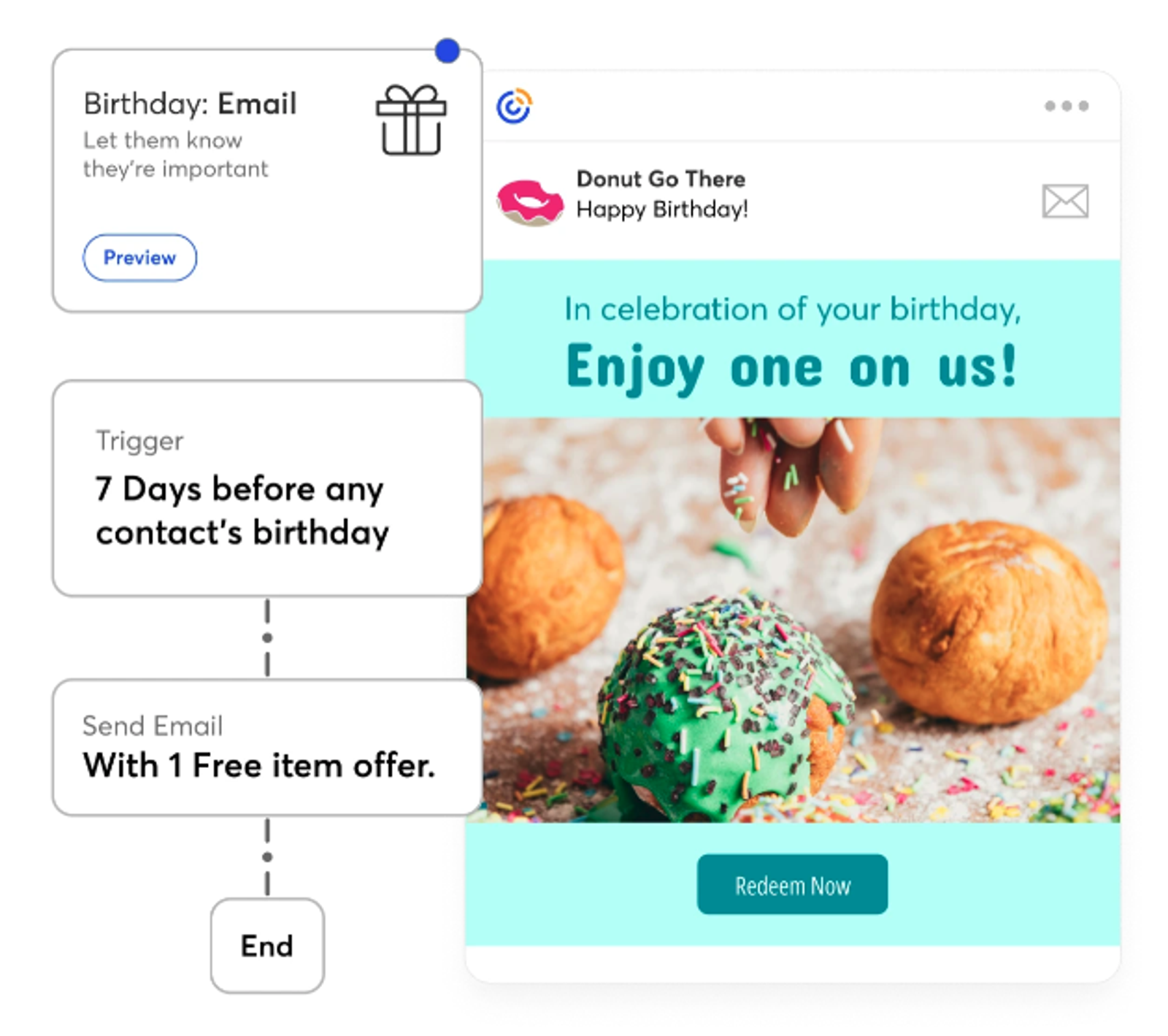
Key email marketing features Constant Contact offers:
- Easy-to-use email editor: Design your emails with a drag-and-drop editor that's simple and straightforward. Choose from a variety of pre-designed templates to quickly create on-brand newsletters, promotions, or event invites without needing any design skills.
- Basic automation: Set up simple automated emails like welcome messages, birthday greetings, or basic drip campaigns to keep in touch with your subscribers. Great for beginners who want to dip their toes into automation without getting overwhelmed.
- Contact list management: Organize and manage your contacts with easy-to-use tools. You can upload lists, tag subscribers, and segment your audience based on basic data like location or engagement level.
- Reporting and analytics: Get insights on basic metrics like open rates, click rates, and bounce rates. Track performance over time to see how your emails are doing and identify areas for improvement.
- Basic A/B testing: Test different subject lines to find out which one gets better engagement. This is a good starting point if you’re just learning about optimizing your emails.
- Email scheduling: Schedule your emails to be sent at the optimal time, ensuring your message lands in your subscribers' inbox when they're most likely to read it.
Constant Contact is designed to be easy to use, so you can quickly create and send newsletters or promotional emails without needing a lot of technical know-how. But keep in mind, its features are pretty basic compared to other platforms, so if you’re looking for advanced tools like complex automation or deep segmentation, you might find it a bit limited.
ActiveCampaign on the other hand, provides advanced features like advanced automation, dynamic content, deep personalization, and powerful segmentation, making it a great choice for businesses that want to get creative with their marketing strategies.
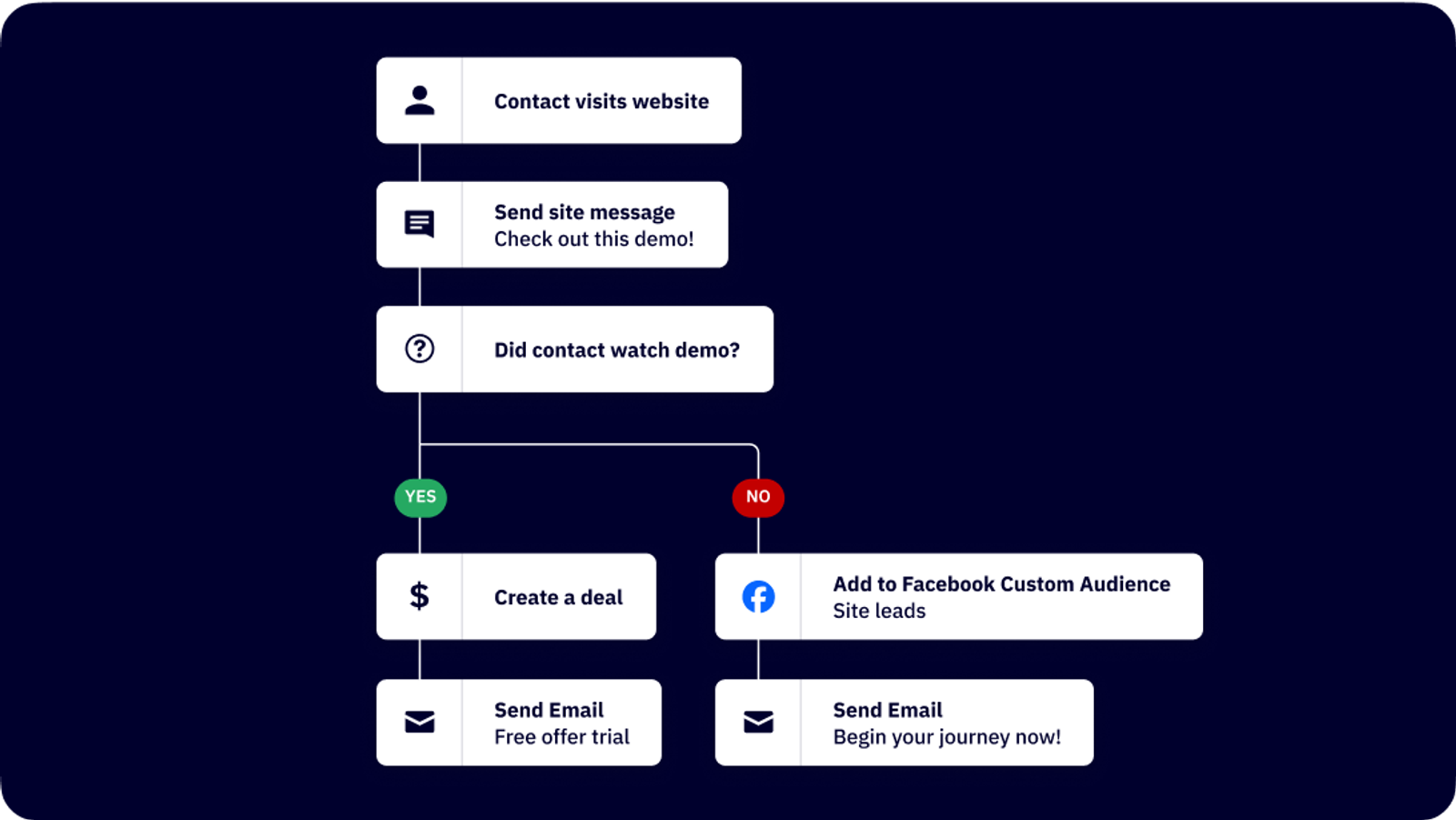
Key email marketing features ActiveCampaign offers:
- Advanced automation: Create complex, multi-step workflows that go beyond just emails. You can automate actions like sending SMS, updating CRM records, or tagging contacts based on their behavior, helping you build a connected customer journey from start to finish.
- Personalization and dynamic content: Use dynamic content to tailor your emails to each recipient based on their actions, interests, or past purchases. This means every email can feel like a one-on-one conversation rather than a mass message.
- Segmentation: Group your audience into highly specific segments based on behavior, location, engagement level, purchase history, and more. Always send targeted emails that speak directly to the needs and interests of each group.
- A/B testing: Test different versions of your emails—from subject lines and images to call-to-action buttons—to see what gets the best response. Use the results to fine-tune your future campaigns for maximum impact.
- AI features: Leverage AI tools like predictive content and predictive sending to automatically optimize your emails for better engagement. This means sending the right content at the right time, boosting your chances of conversion.
- Email templates and customization: Start with a library of professional templates or design your own from scratch. The drag-and-drop builder makes it easy to create beautiful, on-brand emails without needing a design degree.
- Conditional content: Customize different sections of your email based on each recipient's profile or behavior. For example, you can show a special offer to loyal customers and a different message to new leads—all in the same email.
In short, ActiveCampaign is packed with advanced features for those looking to level up their email marketing game, while Constant Contact keeps things simple and straightforward for businesses that just need the basics.
Choose the platform that’s #1 in email deliverability
If you’re taking the time to design and automate your emails, you want people to see them, right? From the past three deliverability tests EmailTooltester ran this year, ActiveCampaign scored first over all other platforms with a 93.4% deliverability rate. Constant Contact came in second and scored a 92% for deliverability.

Deliverability is massively important because an undelivered or lost to the spam folder email is practically useless. When you choose ActiveCampaign, you can be certain that more of your contacts will see the emails you send and increase your chances of interaction (and hopefully conversion).
Advanced marketing automation or simple… you choose
Marketing automation is a key differentiator between ActiveCampaign and Constant Contact, with each platform catering to different business needs. ActiveCampaign stands out with its simple but powerful automation features, while Constant Contact provides more basic automation capabilities suitable for simpler marketing efforts.
Do you want to make sure your customers get a purchase confirmation email? Would you like to push visitors who left your website with items in their cart to complete their purchase? Or maybe you’re hosting an event and want to send consistent reminders to attendees? You can do all that in ActiveCampaign with just a few simple clicks.
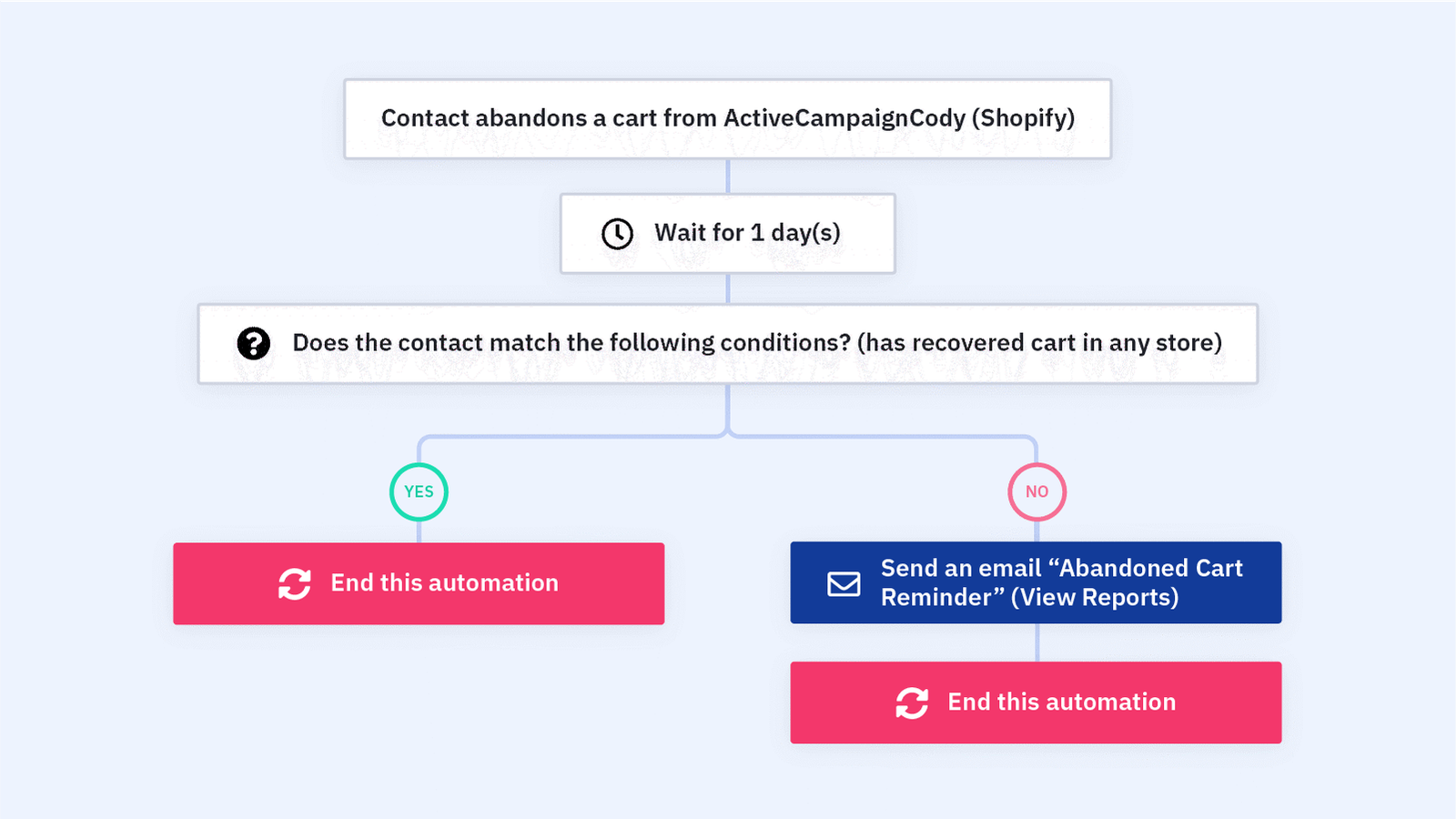
ActiveCampaign is all about powerful automation. It offers a visual automation builder that allows you to create complex, multi-step workflows that can include emails, SMS, site messages, and even CRM updates. You can easily set up automated sequences that change based on user behavior—like sending a follow-up email if someone clicks a link or tagging a contact if they make a purchase.
This means you can send messages that are relevant to each person at just the right time. Plus, the visual automation builder is user-friendly and provides a clear overview of the entire workflow, making it easy to create, modify, and manage complex automation sequences.
ActiveCampaign’s key marketing automation features:
- Advanced automation workflows: Create multi-step workflows that include emails, SMS, site messages, and CRM actions, all triggered by specific customer behaviors.
- Conditional logic: Set up automated sequences that adapt based on actions like email opens, link clicks, or website visits.
- Dynamic content: Personalize emails with content that changes based on user data and behavior.
- AI features: Utilize predictive tools to optimize sending times and content for better engagement.
Watch this video from EmailTooltester that walks through ActiveCampaign’s email editor, creating an automation workflow, and discusses why it’s their #1 choice for an email marketing platform.
Constant Contact, on the other hand, keeps its automation tools pretty simple. It’s great if you’re looking for basic automation, like setting up welcome emails, birthday greetings, or simple drip campaigns. You can automate follow-ups based on simple triggers, like when someone joins your list or clicks a link in an email. While these features are easy to use and perfect for small businesses or beginners, they don’t offer the same depth of automation or customization as ActiveCampaign.

If you need straightforward, basic automation, Constant Contact might be all you need. But if you’re ready to dive into more advanced strategies and want to build highly personalized, multi-channel marketing automations, ActiveCampaign clearly takes the lead with its richer set of automation features and flexibility.
Constant Contact’s key marketing automation features:
- Basic automation: Set up simple automated emails like welcome messages, birthday greetings, and basic drip campaigns.
- Simple triggers: Automate follow-ups based on actions like signing up for your list or clicking a link.
- Event marketing automation: Manage and automate communications related to events, like reminders and follow-ups.
- Pre-built templates: Use ready-made automation templates to quickly get started without needing to build from scratch.
CRM functionality: fully integrated vs. external
ActiveCampaign has a deeply integrated CRM system that is fully embedded within its platform. This integration allows you to manage customer interactions and track deals directly within the platform, connecting your email marketing, sales, and automation efforts in one place.

ActiveCampaign’s CRM is not just an add-on but a core component of its platform, designed to work in tandem with its marketing automation features.
Key features of ActiveCampaign’s CRM:
- Customizable pipelines: Set up and manage sales pipelines with a flexible, Kanban-style interface that lets you visualize and track your sales process.
- Lead scoring: Automatically score leads based on their behavior and engagement, helping you prioritize follow-ups and tailor your outreach.
- Detailed contact records: Access detailed contact profiles with information on interactions, tags, and activity history, so you have a complete view of each customer.
- Automation integration: Connect your CRM with automation workflows to trigger actions based on customer data, like sending a follow-up email when a deal is updated.
Constant Contact, while offering CRM capabilities, approaches integration differently. Unlike ActiveCampaign, Constant Contact does not have a fully integrated CRM system within its platform. Instead, it provides integration options with external CRM systems such as Salesforce and HubSpot.

This means that while users can connect their email marketing efforts with a CRM, they are working with separate systems that must be synced together.
Key features of ActiveCampaign’s CRM:
- Basic CRM features: Manage your contact list with tools for organizing and segmenting your audience, but it’s not as deep as some other platforms.
- Contact management: Store and manage contact details with simple tagging and list management options to keep your data organized.
- Basic reporting: Get basic insights into your contact engagement and sales performance, but without the detailed analytics offered by more advanced CRM systems.
- Event management: Track and manage event registrations and interactions with your contacts, integrating smoothly with Constant Contact’s event marketing tools.
ActiveCampaign offers a more advanced and integrated CRM with features designed for deeper customer insights and automation, while Constant Contact provides essential CRM tools that are suited for those who may not need to be as in the weeds just yet.
Templates and email design: lackluster vs. modern
Constant Contact provides a range of email templates that are simple and easy to use, although they can feel a bit outdated compared to some newer options. Still, they get the job done for small businesses and those who don’t need anything too flashy.

Their editor allows you to drag and drop elements to customize your emails and offers basic design options to help you stay on brand. It’s straightforward and great for users who prefer to keep things simple.
Key features of Constant Contact’s email templates:
- Easy-to-use templates: Basic designs that are straightforward to customize.
- Drag-and-drop editor: Add and arrange elements without needing any design skills.
- Mobile-friendly layouts: Templates that adjust for different devices, though not as refined as others.
- Image library access: Built-in access to stock images and editing tools.
- Basic branding options: Keep your emails on-brand with simple customization tools.
ActiveCampaign offers 250+ free, modern, and customizable email templates that are not only visually appealing but easy to tweak to fit your brand. Their drag-and-drop builder is user-friendly and designed to help you quickly add elements like images, buttons, and dynamic content.
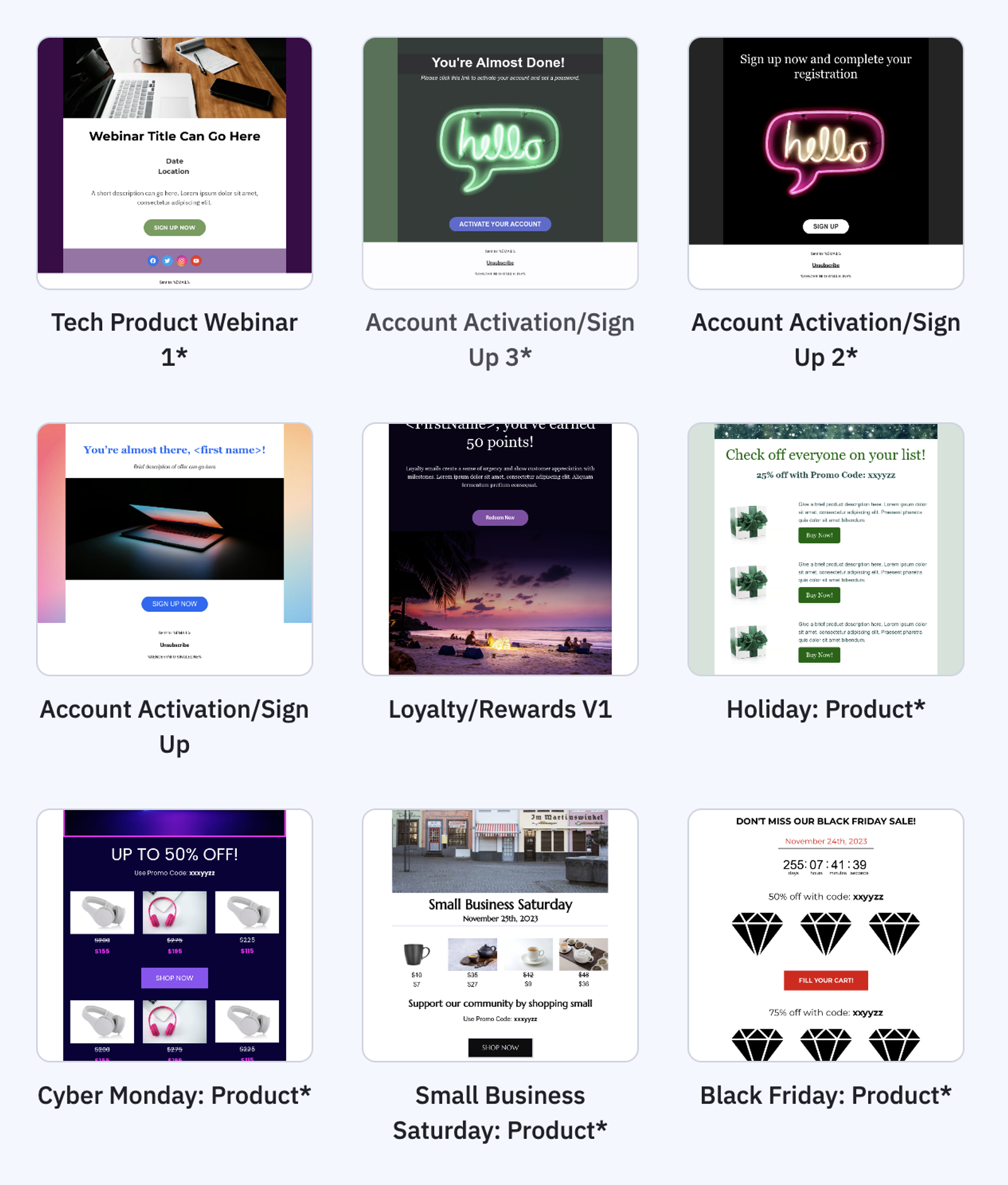
The templates are responsive and adapt well to different devices, ensuring your emails look great everywhere. Plus, you can save your own designs for future use or build from scratch if you’re feeling creative.
Key features of ActiveCampaign’s email templates:
- Modern, responsive templates: Designed to look great on any device.
- Drag-and-drop editor: Easily customize your emails with text, images, buttons, and more.
- Dynamic content blocks: Personalize content based on customer behavior and preferences.
- Custom template saving: Save your favorite designs for easy reuse.
- HTML editing: For those who want full creative control, you can tweak templates with your own code.
ActiveCampaign also offers their AI Brand Kit that allows you to generate consistent, on-brand campaigns and content so you have more time to focus on more strategic work. You can easily import your brand’s colors, fonts, logos, and social links directly from your website or domain and save them as a brand kit that’s available to customize all your content.
Discover how ActiveCampaign’s AI Brand Kit can save you hours of design work and ensure your content is always on-brand.
Plus, ActiveCampaign will analyze this information and create AI-generated campaign templates for you. Find more information here.
Reporting and analytics: there’s a clear winner
Analytics are key to knowing how your campaigns are performing and finding ways to improve them. To boost results, you need the data. Constant Contact’s reporting, however, is fairly basic and limited.
Their reporting options are good for those just getting started, but they're more basic compared to what ActiveCampaign provides. You’ll get all the essentials—like open rates, clicks, bounces, and unsubscribes—making it a good fit for email marketing beginners.
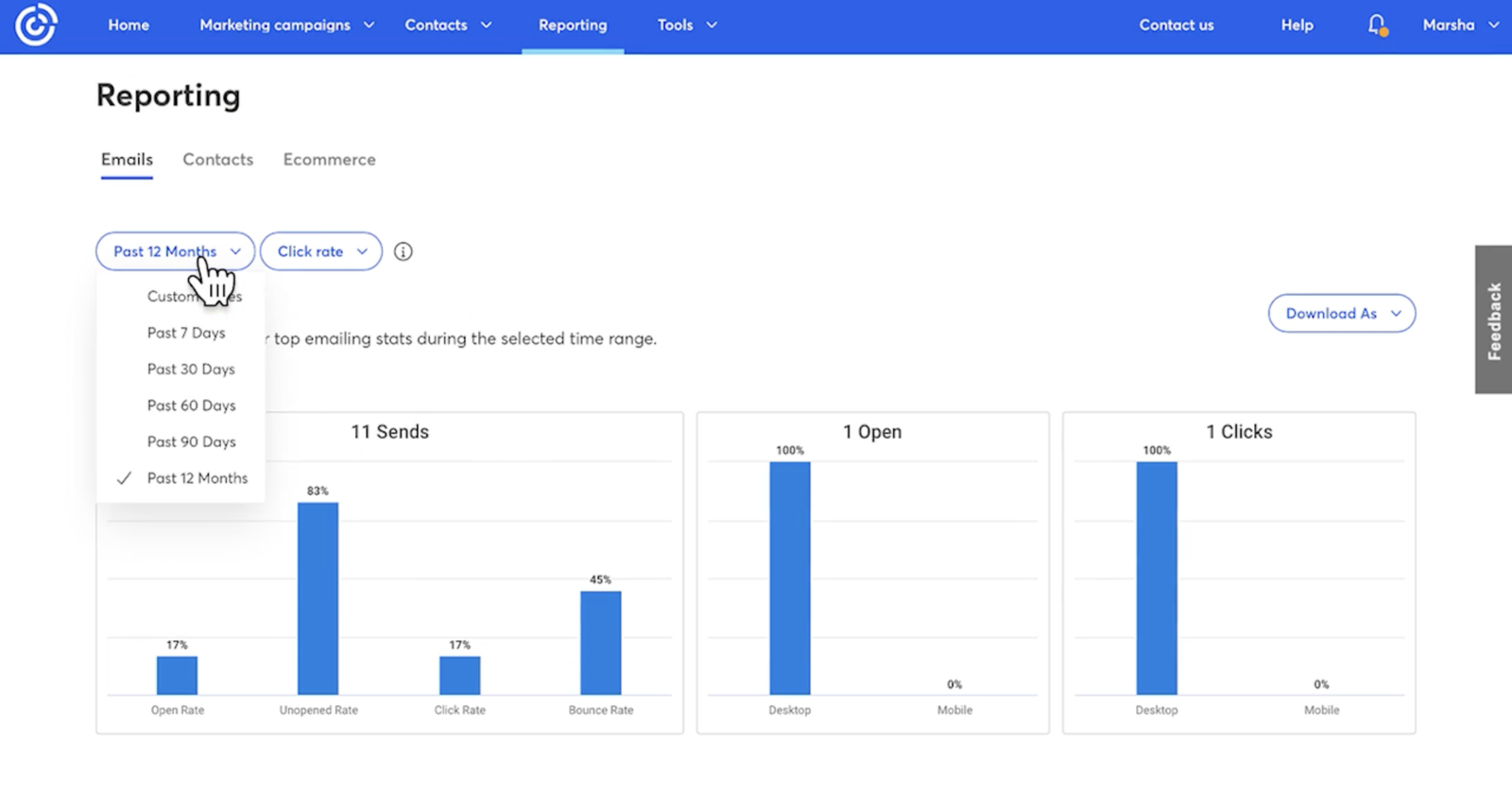
Their reports are easy to understand and provide a good snapshot of how your emails are doing, with simple visual dashboards that help you keep track of the basics without getting overwhelmed.
Constant Contact’s reporting features:
- Basic performance metrics: You can track key stats like opens, clicks, bounces, and unsubscribes to get a clear sense of how your emails are performing. While these metrics are useful, there are no details or no trends to glean. You aren’t able to compare your campaigns with each other to see which performed better.
- Visual dashboards: The platform presents data in easy-to-read charts and graphs, making it simple to grasp your campaign results at a glance. Whether you're looking at performance over time or comparing different emails, the visuals help you quickly interpret the data without digging through spreadsheets.
- Social media and event reporting: Constant Contact lets you track how your emails perform when shared on social media and integrates event marketing into your reports. This is particularly useful for businesses that frequently host webinars, workshops, or local events and want to see the full picture of their outreach efforts.
- Heat maps: Heat maps visually show which parts of your emails are getting the most clicks, helping you understand which links, buttons, or images are capturing attention.
Note: Even with the features listed above, Constant Contact’s reports won’t help you figure out what kinds of customers are responding to what kinds of campaigns. You won’t know the nitty gritty like if your campaign resonated with men in their thirties from Colorado. Their reporting lacks that granularity, leaving you to blindly guess how you should tweak your strategy.
On the other hand, ActiveCampaign provides detailed reporting and analytics tools that give you a clear view of how your campaigns are performing. You can track everything from basic metrics like open and click rates to more advanced data, like revenue generated from specific campaigns.

With options to dig deep into contact behavior and engagement patterns, ActiveCampaign helps you understand your audience better and make data-driven decisions. Their reports are customizable, allowing you to focus on the metrics that matter most to your business.
ActiveCampaign’s reporting features:
- Advanced performance metrics: Go beyond basic open and click rates by tracking metrics like conversions, goal completions, and engagement over time. You can see how each email or campaign contributes to your overall goals, allowing for more targeted optimizations.
- Revenue reports: Easily identify which emails are directly contributing to your sales. These reports link marketing activities to actual revenue, giving you a clear picture of ROI and helping you prioritize the most effective campaigns.
- Engagement tracking: Monitor how contacts are interacting with your emails, website, and other channels. This multi-channel view shows the complete customer journey, from the first touchpoint to conversion, so you can see what’s working and where customers might be dropping off.
- Customizable dashboards: Create dashboards that highlight the metrics most relevant to your business. Whether you’re interested in tracking email performance, customer lifetime value, or specific audience behaviors, you can tailor your view to focus on what matters most to you.
- Predictive analytics: Leverage AI to predict future outcomes, like the best times to send emails or the likelihood of a contact converting. These tools help you optimize campaigns and content, making adjustments before you see a drop in performance, so you’re always one step ahead.
Overall, ActiveCampaign’s reporting is more extensive and geared toward businesses that want deeper insights, while Constant Contact offers straightforward reporting that’s ideal for beginners who need just the basics to start measuring their email performance.
950+ integrations vs. 300
In ActiveCampaign’s app marketplace, you’ll find 950+ apps that integrate with various tools and platforms, including CRM systems, e-commerce platforms, and other marketing tools. It supports connections with popular services like Salesforce, Shopify, WooCommerce, and hundreds more.
Constant Contact also offers a range of integrations, but it’s much more limited than ActiveCampaign. Their 300 integrations include apps like Salesforce, Canva, Shopify, WordPress, and more.
The platform that’s right for you will ultimately come down to which tools you’re already using and if ActiveCampaign or Constant Contact can easily integrate with them. By and large, ActiveCampaign offers more flexibility and power when it comes to connecting all your apps together (which makes every function a lot easier).
Pricing: similar pricing, but one platform boasts more features
ActiveCampaign and Constant Contact have somewhat similar pricing structures. Let’s break it down.
Constant Contact pricing
Constant Contact’s entry-level pricing starts with their Lite plan at $12/month. It should be noted that on their pricing page, there’s no indication of how many contacts come with the pricing reflected in each tier. You can only find that if you click on the small text under the tiers that says “See pricing tiers”. For the standard 1,000 contacts, the Lite plan will really cost you $30/month while the Standard plan costs $55/month and the Premium plan costs $110/month.
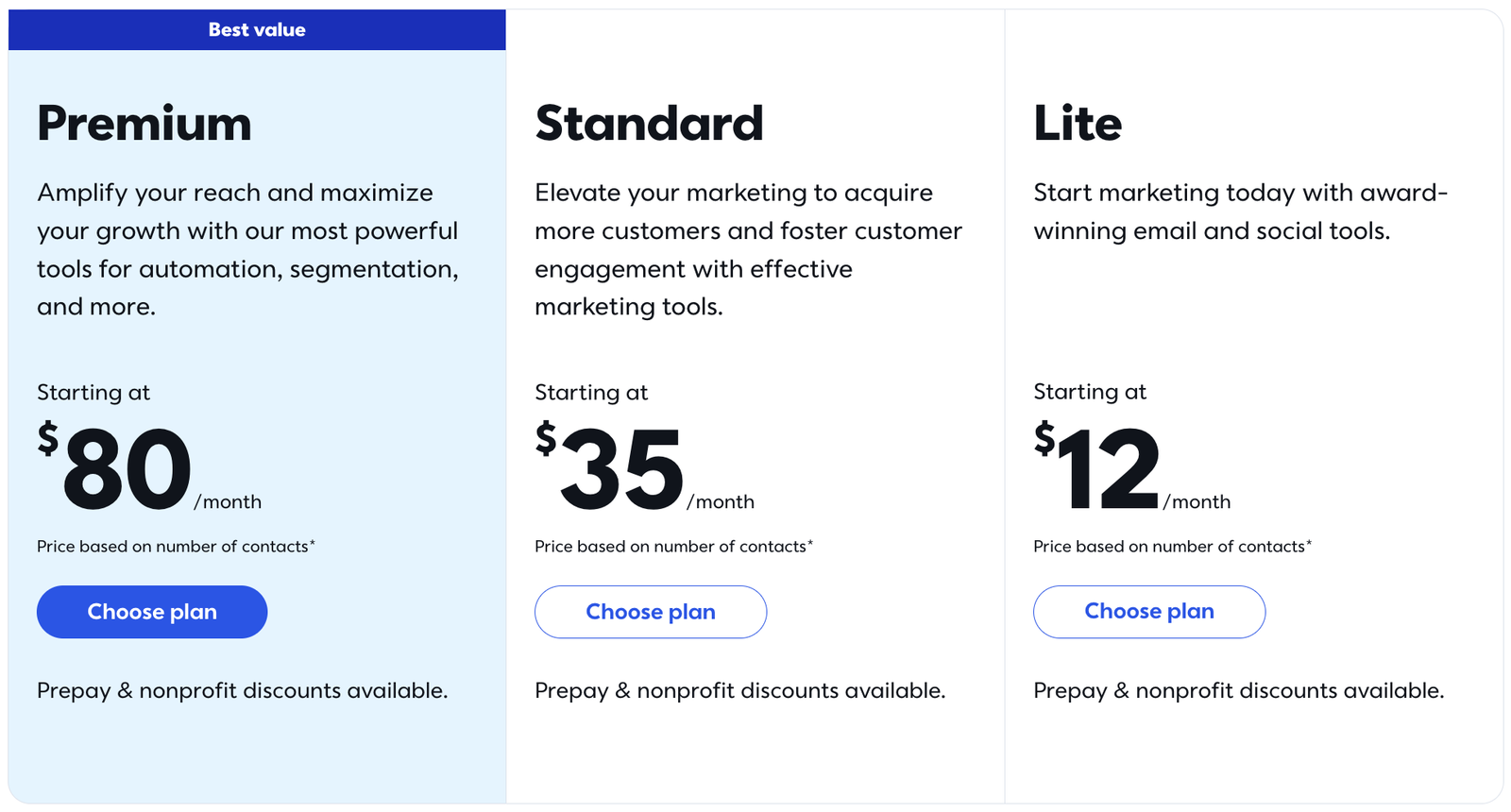
This is something to keep in mind because the pricing on ActiveCampaign’s site already reflects up to 1,000 contacts, making them quite a bit more affordable. By double, actually.
Their Lite plan starts at $30/month (with 1,000 contacts), making it doubly as expensive as ActiveCampaign’s entry-level plan. The Lite plan covers the basics of email marketing, including customizable templates, list management, and basic reporting.
Lite allows you to send up to 10x your number of contacts and gives you features like:
| 1 user and 1 GB of storage | Web sign-up forms |
|---|---|
| Self-service, live chat, and phone support | Registration forms and payments for events |
| Drag and drop email templates | The ability to sell products and services |
| BrandKit | Social media reporting |
| AI content recommendations | Marketing campaign calendar |
| Polls and surveys | 300+ integrations |
| Reach and engagement reporting | Posting to Facebook, Instagram, and LinkedIn |
| Automated welcome emails | Contact management |
You’re also able to include specific add-ons with your chosen plan like the inbox preview add-on for $10/month and the SMS campaigns add-on for $10/month. If you decide to add SMS marketing to your plan, you’ll also get features like text-to-join and SMS reporting. These are additional charges on top of the plan’s price.
Moving to the Standard plan, you’ll pay $55/month (with 1,000 contacts), can send 12x your contact limit, and get everything in the Lite plan plus these features.
The Standard plan gives you access to:
| Newsletter archive | Resend to non-openers |
|---|---|
| Scheduled email sends | Reach and engagement reporting |
| Subject line A/B testing, recommendations, and personalization | 2 additional users and 10 GB of storage |
| Drilldown reporting | Contact activity segmentation |
| Automation path templates | Schedule social posts in advance |
| Contact segmentation | Social media ads manager |
| Custom segmentation | And their Campaign Builder |
Finally, Constant Contact’s Premium plan starts at $110/month (for 1,000 contacts) and is built to amplify your reach and maximize your growth with additional automation, segmentation, and more. It allows monthly email sends up to 24x your number of contacts.
With Premium, you’ll get everything from Standard plus features like:
| Unlimited users and 25 GB of storage | Custom automation paths |
|---|---|
| Dedicated, priority support | Google Ads Manager |
| Dynamic content in email | Revenue reporting |
| Engagement heat map | And SEO recommendations |
| Custom automation paths |
The Premium plan also allows you to send SMS campaigns with up to 500 messages a month.
ActiveCampaign pricing
Compared to similar enterprise-level automation tools like HubSpot or Salesforce, ActiveCampaign is pretty budget-friendly for the amount of features you get. They don’t offer a free plan (just a free two-week trial), but their Starter plan gives you access to some pretty advanced features for only $15/month.

The prices above are based on a max of 1,000 contacts.
To start, ActiveCampaign’s entry-level pricing starts at $15/month. This plan, aptly named the Starter plan, gives you access to multi-step marketing automation right out of the gate. Constant Contact’s Lite plan only gives you automated welcome emails and even when you move up to their highest tier, the only additional automation features you’ll get are resends to non-openers, automation path templates, and custom automation paths.
When you choose ActiveCampaign’s Starter plan, you get access to features like:
| 10,000 monthly email sends | An AI-powered automation builder |
|---|---|
| 5 actions and triggers per automation | Limited segmentation |
| Email campaigns and newsletters | Over 250 email templates |
| Basic and inline web forms | Limited reporting and analytics |
| The ActiveCampaign Marketing CRM | Over 900 integrations including standard e-commerce apps |
| A/B testing on emails | And site tracking |
| 900+ automation recipes |
Moving up to the Plus plan, you unlock more automation and powerful customer insights for $49/month with 1,000 contacts.
The Plus plan adds features like:
| Unlimited triggers and actions for your automations | Prospecting and retargeting ads for Google, Facebook, and LinkedIn |
|---|---|
| Web forms | Basic segmentation |
| Landing pages (and templates) | Basic reporting and analytics |
| Generative AI functionality | And revenue reporting |
With the Plus plan and up, you can add on the pipeline enhanced CRM to manage your sales automation or the sales engagement CRM that includes additional email and AI capabilities.
ActiveCampaign’s Pro plan will cost you $79/month to unlock full omnichannel marketing automation. This is where you can truly elevate your email marketing. You’ll have monthly email sends 12x your contact limit and three users instead of one.
ActiveCampaign’s Pro plan gives you access to additional features like:
| A/B testing on automations | Conditional content |
|---|---|
| Advanced segmentation, reporting, and analytics | And attribution and conversion tracking |
| Predictive sending |
The Pro plan allows you to get more granular about how your email campaigns are performing and understand what content, messaging, and offers move the needle for your business. You’ll have total control over your email cadence.
Finally, ActiveCampaign’s Enterprise plan starts at $145/month for 1,000 contacts and allows you monthly email sends 15x your contact limit plus five users.
With the Enterprise plan, you get everything previously mentioned plus:
| Premium segmentation | Custom objects |
|---|---|
| Premium CRM integrations with Salesforce, Microsoft Dynamics, and more | Premium reporting and analytics |
| Single sign-on (SSO) | And a dedicated account team |
No matter which ActiveCampaign plan you choose, ActiveCampaign offers services like contact migration, customer enablement workshops, chat and ticket support, video tutorials, a knowledge base, and help guides to help you get the most out of the platform so you can focus on running your business.
It’s important to note the value each platform provides at their respective price points. While Constant Contact may seem more affordable initially, especially for businesses just starting, ActiveCampaign’s pricing structure offers more value as businesses grow and require more advanced features.
The ability to scale up within ActiveCampaign’s ecosystem, accessing more powerful marketing automation and CRM tools as needed, can lead to better long-term results and potentially higher returns on investment.
Why do people switch from Constant Contact to ActiveCampaign?
We know you’re aware that you’re on the ActiveCampaign website reading a comparison between us and a competitor but there really is a reason why so many people choose to migrate away from their current marketing automation platform. We’ve seen plenty of customers migrate and see real results.
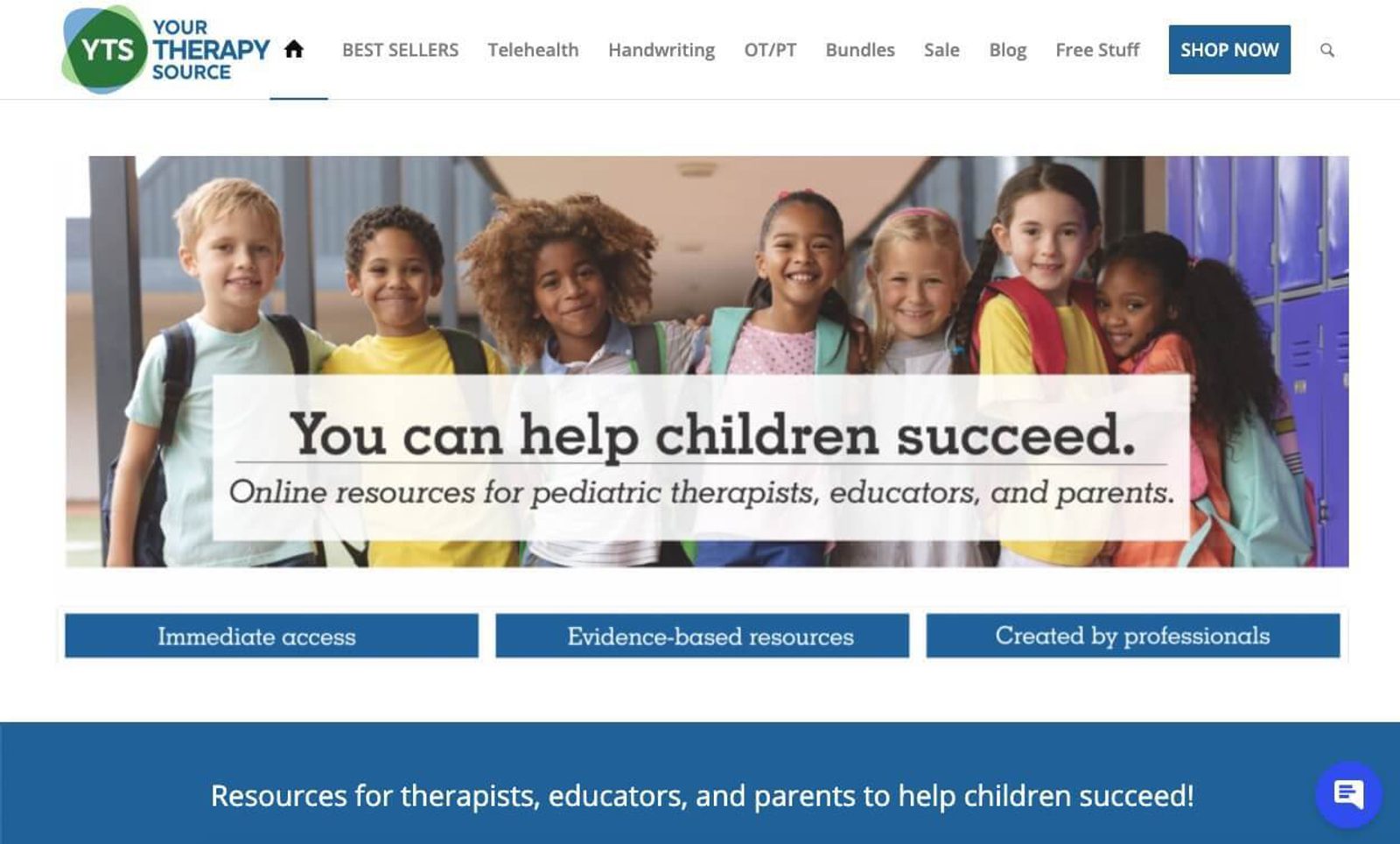
When Your Therapy Source chose to switch from Constant Contact to ActiveCampaign, they gained full insight into the type of resources customers need which began driving the direction of content creation. Plus, they saw a 2000% return on the money they invested in ActiveCampaign and noticed that 50% of all sales were coming from their weekly emails.
ActiveCampaign or Constant Contact: which is best for you?
The platform you choose will depend on which features above are most important to you (and which you need to grow your business).
Choose ActiveCampaign if… you’re a growing business, franchise, or e-commerce company that needs advanced automation and a powerful CRM that will help you create and manage all types of customer journeys.
ActiveCampaign is great for businesses that need powerful marketing automation and advanced email features without a lot of extra frills—perfect for small to mid-sized teams looking for deep customization and data-driven decisions.
Choose Constant Contact if… you’re a beginner in need of a basic email marketing platform that offers decent campaigns, automation, and event marketing.
Constant Contact is a solid choice for beginners or smaller businesses who want a straightforward way to get started with email marketing. It's easy to use and covers the basics well, but it might feel a bit limited as your needs grow and you start needing more functionality.
What are real customers saying about each platform?
| Pros: “Very user-friendly and designing visually appealing emails takes no time. I also appreciate the detailed report I receive after sending my email campaigns, which helps me to measure the success of my campaigns and make improvements for the next one.” | Cons: “If a business has advanced automation needs, Constant Contact may not be the best fit. While it does offer some basic automation features, other platforms might be better suited if you require sophisticated automation workflows or customer journey mapping.” |
|---|
| Pros: “I was on another marketing platform for a few years and found it tough to navigate. I found ActiveCampaign fairly intuitive to find what you need, make adjustments, and publish website forms, newsletters, nurture emails, etc.” | Cons: “We have very few complaints. There are occasionally some buggy issues with Captcha settings.” |
|---|
Frequently asked questions
Lingering questions? We've got you.
💡 Is Constant Contact good for email marketing?
Constant Contact is a good option for email marketing if you’re looking for something simple and easy to use. It covers all the basics—like creating emails, tracking opens and clicks, and even managing events and social media posts—all in one place. The platform is user-friendly and offers plenty of templates to get you started.
However, if you're looking for more advanced features, like complex automation or deep personalization, you might find it a bit limiting as your email marketing strategy evolves. So, it’s great for getting started but might not be the best fit if you want to go big.
💡 Can you use Constant Contact as a CRM?
You can use Constant Contact as a basic CRM, but it’s pretty limited compared to dedicated CRM tools. It does a decent job of managing your contacts, tracking their activity, and segmenting them into different lists. You can also add notes, set reminders, and view some basic engagement data.
If you’re looking for more advanced CRM features, like deal tracking, sales pipeline management, or deep customer insights, Constant Contact might not have everything you need. It's a good option for those who need simple contact management without all the bells and whistles.
💡 Who is ActiveCampaign good for?
ActiveCampaign is ideal for businesses that want to take their marketing to the next level with powerful automation and personalization features. It’s a great fit for small to mid-sized teams who need advanced tools to automate their marketing, segment their audience, and track detailed performance metrics.
If you're looking for a platform that offers deep customization, predictive analytics, and a visual workflow builder to create tailored customer experiences, ActiveCampaign could be a perfect match. It’s especially useful if you have a bit of experience with email marketing and want to leverage more sophisticated strategies to drive growth.
💡 What is the biggest difference between ActiveCampaign and Constant Contact?
The biggest difference between ActiveCampaign and Constant Contact is the level of sophistication in their features. ActiveCampaign has a focus on advanced automation and deep personalization, offering powerful tools for creating complex, multi-step workflows and detailed performance insights. It’s great for businesses that need a lot of customization and want to dive into data-driven marketing.
Constant Contact focuses on simplicity and ease of use with more basic features that are ideal for beginners or small businesses just starting out. While it covers the essentials well, it doesn’t offer the same depth of automation or advanced analytics that ActiveCampaign does.